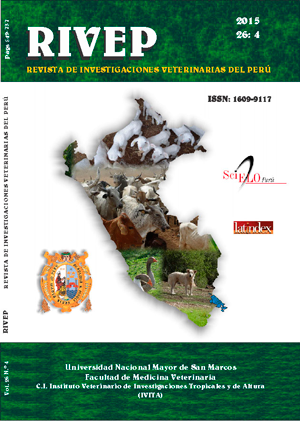A serological and molecular survey of Ehrlichia canis in dogs from a community in Aragua State, Venezuela
DOI:
https://doi.org/10.15381/rivep.v26i4.11220Keywords:
Ehrlichia canis, ehrlichiosis, IFI, PCR, Rhipicephalus sanguineus, VenezuelaAbstract
The aims of the study were to determine the prevalence of antibodies anti-E canis and the molecular detection of E. canis as well as to determine the species and level of tick infestations in dogs from a rural community in Aragua state, Venezuela. Blood samples from 110 domestic dogs were obtained and analyzed by Indirect Immunofluorescence (IFI) and Nested Polymerase Chain Reaction (PCR). The seroprevalence was 77.3% and the molecular detection was 45.2%. The percentage of dogs infested with ticks was 69%, mostly with Rhipicephalus sanguineus. The results showed that 80% (68/85) of seropositive dogs and 32% (8/25) of seronegative dogs were tick infested (OR=8.5, 95%, CI 3.19 to 22.6; p<0.00001).Downloads
Downloads
Published
Issue
Section
License
Copyright (c) 2015 María del Carmen Martínez A., Cruz María Arraga-Alvarado, Francisco Javier Triana-Alonso, Johanny Alejandra Ruiz C., Clara Nancy Gutiérrez G.

This work is licensed under a Creative Commons Attribution-NonCommercial-ShareAlike 4.0 International License.
AUTHORS RETAIN THEIR RIGHTS:
a. Authors retain their trade mark rights and patent, and also on any process or procedure described in the article.
b. Authors retain their right to share, copy, distribute, perform and publicly communicate their article (eg, to place their article in an institutional repository or publish it in a book), with an acknowledgment of its initial publication in the Revista de Investigaciones Veterinarias del Perú (RIVEP).
c. Authors retain theirs right to make a subsequent publication of their work, to use the article or any part thereof (eg a compilation of his papers, lecture notes, thesis, or a book), always indicating the source of publication (the originator of the work, journal, volume, number and date).










